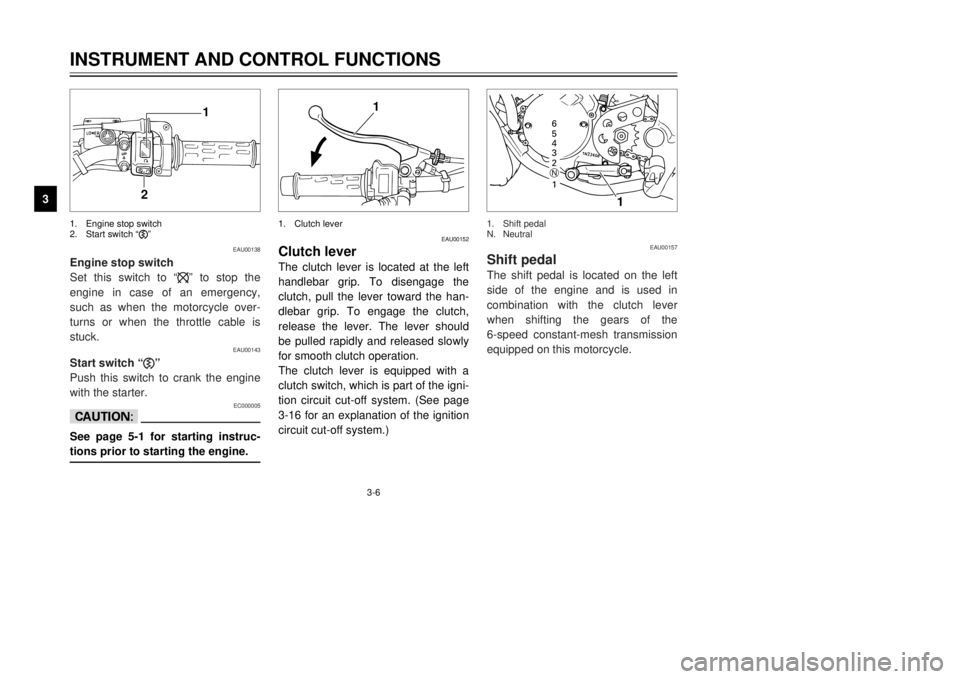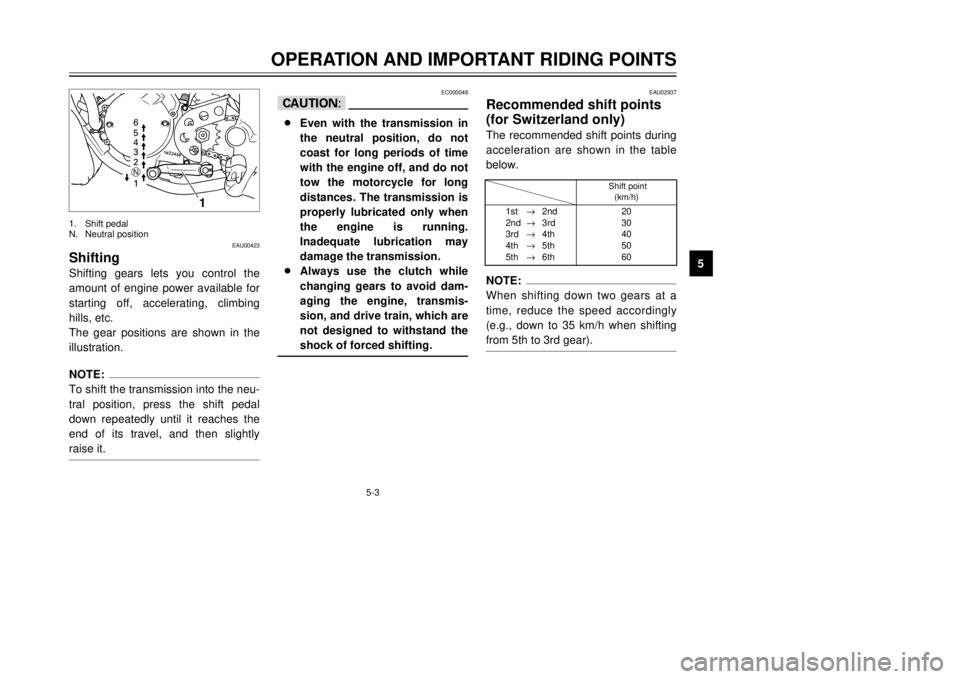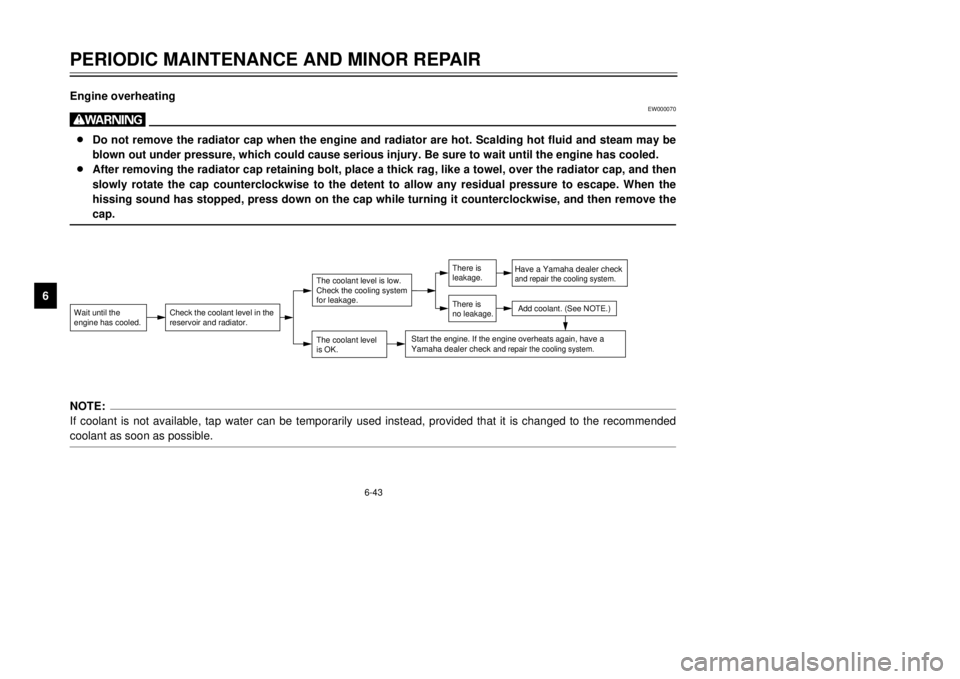Page 17 of 94

EAU00152
Clutch leverThe clutch lever is located at the left
handlebar grip. To disengage the
clutch, pull the lever toward the han-
dlebar grip. To engage the clutch,
release the lever. The lever should
be pulled rapidly and released slowly
for smooth clutch operation.
The clutch lever is equipped with a
clutch switch, which is part of the igni-
tion circuit cut-off system. (See page
3-16 for an explanation of the ignition
circuit cut-off system.)
3-6
INSTRUMENT AND CONTROL FUNCTIONS
1
23
4
5
6
7
8
9
1
1.Clutch lever
6
5
4
3
2
1 N
1
EAU00157
Shift pedalThe shift pedal is located on the left
side of the engine and is used in
combination with the clutch lever
when shifting the gears of the
6-speed constant-mesh transmission
equipped on this motorcycle.1.Shift pedal
N.Neutral
21
EAU00138
Engine stop switch
Set this switch to Ò$Ó to stop the
engine in case of an emergency,
such as when the motorcycle over-
turns or when the throttle cable is
stuck.
EAU00143
Start switch Ò,Ó
Push this switch to crank the engine
with the starter.
EC000005
cCSee page 5-1 for starting instruc-
tions prior to starting the engine.1.Engine stop switch
2.Start switch Ò,Ó
5AE-9-E4 (ENG) 8/30/00 5:04 PM Page 16
Page 18 of 94
3-7
1
EAU00158
Brake leverThe brake lever is located at the right
handlebar grip. To apply the front
brake, pull the lever toward the han-
dlebar grip.1.Brake lever
INSTRUMENT AND CONTROL FUNCTIONS
1
23
4
5
6
7
8
9
1
1.Brake pedal
EAU00162
Brake pedalThe brake pedal is on the right side
of the motorcycle. To apply the rear
brake, press down on the brake
pedal.
1
a
b
EAU02935
Fuel tank capTo open the fuel tank cap
Open the fuel tank cap lock cover,
insert the key into the lock, and then
turn it 1/4 turn clockwise. The lock will
be released and the fuel tank cap can
be opened.
To close the fuel tank cap
1.Push the fuel tank cap into posi-
tion with the key inserted in the
lock.
2.Turn the key counterclockwise to
the original position, remove it,
and then close the lock cover.1.Fuel tank cap lock cover
a.Open.
b.Unlock.
5AE-9-E4 (ENG) 8/30/00 5:04 PM Page 17
Page 34 of 94

5-3
EAU00423
ShiftingShifting gears lets you control the
amount of engine power available for
starting off, accelerating, climbing
hills, etc.
The gear positions are shown in the
illustration.NOTE:
To shift the transmission into the neu-
tral position, press the shift pedal
down repeatedly until it reaches the
end of its travel, and then slightly
raise it.
EC000048
cC8Even with the transmission in
the neutral position, do not
coast for long periods of time
with the engine off, and do not
tow the motorcycle for long
distances. The transmission is
properly lubricated only when
the engine is running.
Inadequate lubrication may
damage the transmission.
8Always use the clutch while
changing gears to avoid dam-
aging the engine, transmis-
sion, and drive train, which are
not designed to withstand the
shock of forced shifting.
OPERATION AND IMPORTANT RIDING POINTS
1
2
3
45
6
7
8
9
6
5
4
3
2
1 N
1
1.Shift pedal
N.Neutral position
EAU02937
Recommended shift points
(for Switzerland only)The recommended shift points during
acceleration are shown in the table
below.NOTE:
When shifting down two gears at a
time, reduce the speed accordingly
(e.g., down to 35 km/h when shifting
from 5th to 3rd gear).
Shift point
(km/h)
1st®2nd
2nd®3rd
3rd®4th
4th®5th
5th®6th20
30
40
50
60
5AE-9-E4 (ENG) 8/30/00 5:04 PM Page 33
Page 79 of 94

6-43
PERIODIC MAINTENANCE AND MINOR REPAIR
1
2
3
4
56
7
8
9Engine overheating
EW000070
w8Do not remove the radiator cap when the engine and radiator are hot. Scalding hot fluid and steam may be
blown out under pressure, which could cause serious injury. Be sure to wait until the engine has cooled.
8After removing the radiator cap retaining bolt, place a thick rag, like a towel, over the radiator cap, and then
slowly rotate the cap counterclockwise to the detent to allow any residual pressure to escape. When the
hissing sound has stopped, press down on the cap while turning it counterclockwise, and then remove the
cap.NOTE:
If coolant is not available, tap water can be temporarily used instead, provided that it is changed to the recommended
coolant as soon as possible.Wait until the
engine has cooled.
Check the coolant level in the
reservoir and radiator.
The coolant level
is OK.The coolant level is low.
Check the cooling system
for leakage.
Have a Yamaha dealer checkand repair the cooling system.Add coolant. (See NOTE.)
Start the engine. If the engine overheats again,
have a
Yamaha dealer check
and repair the cooling system.
There is
leakage.
There is
no leakage.
5AE-9-E4 (ENG) 8/30/00 5:04 PM Page 78